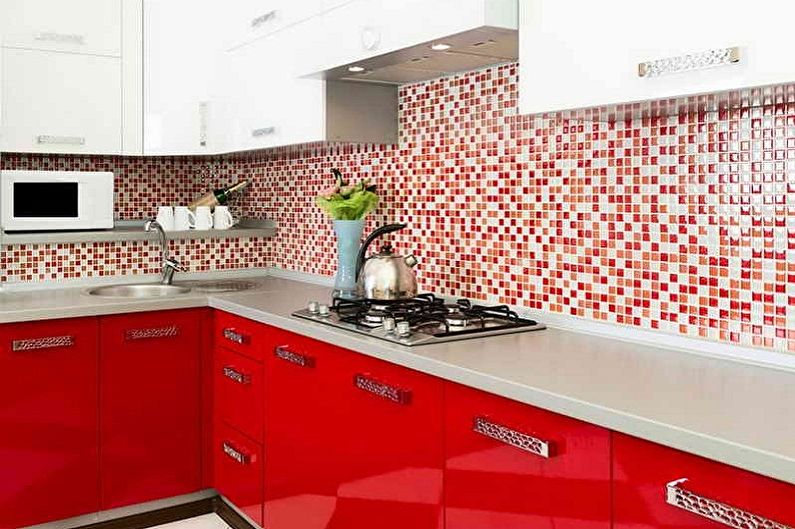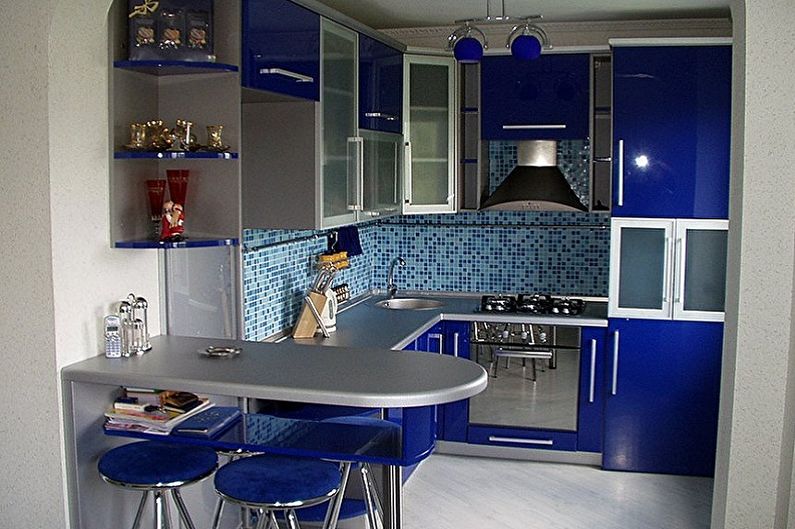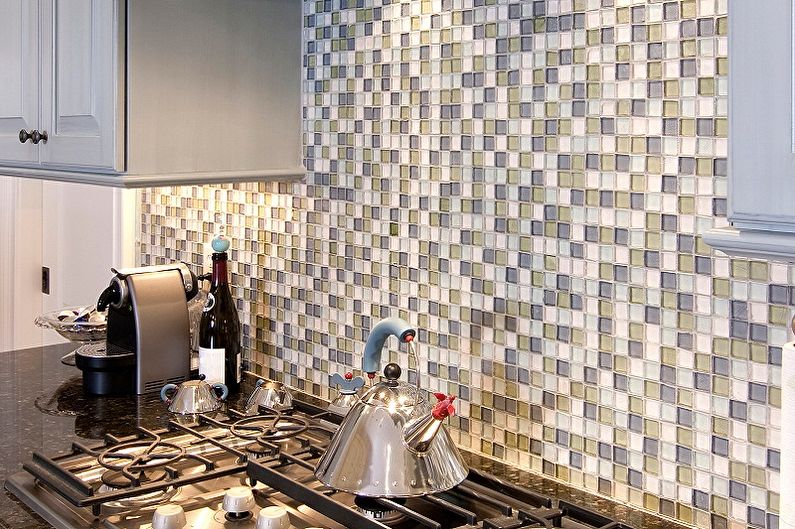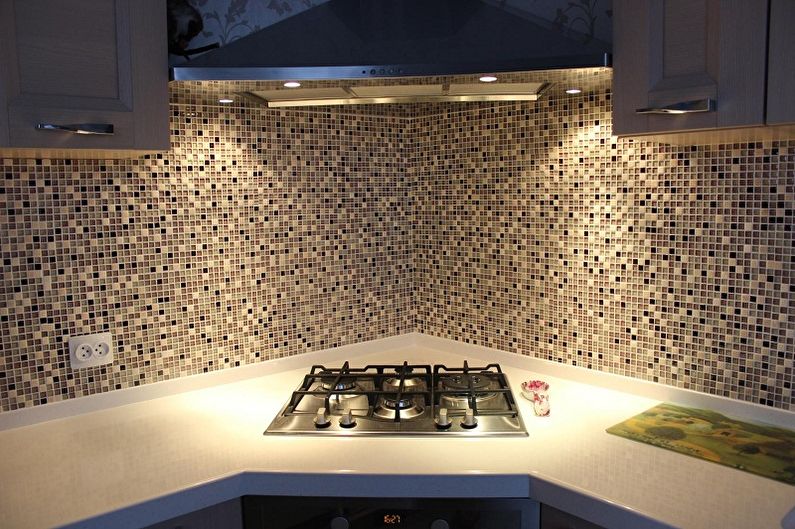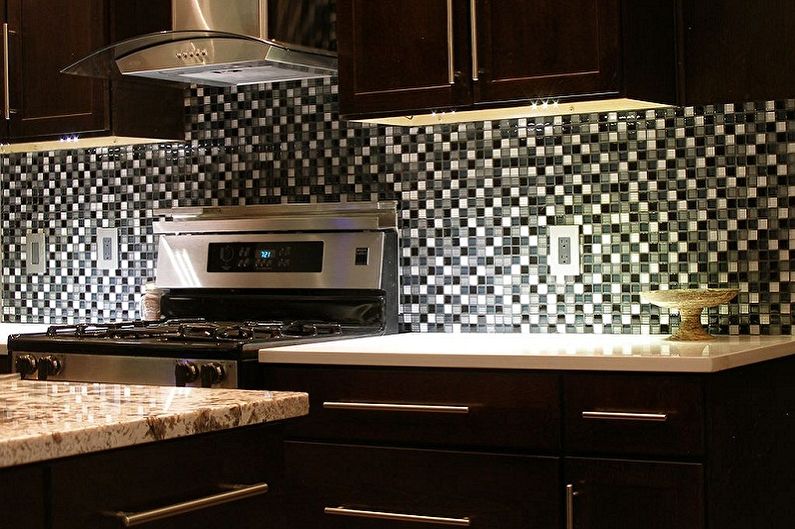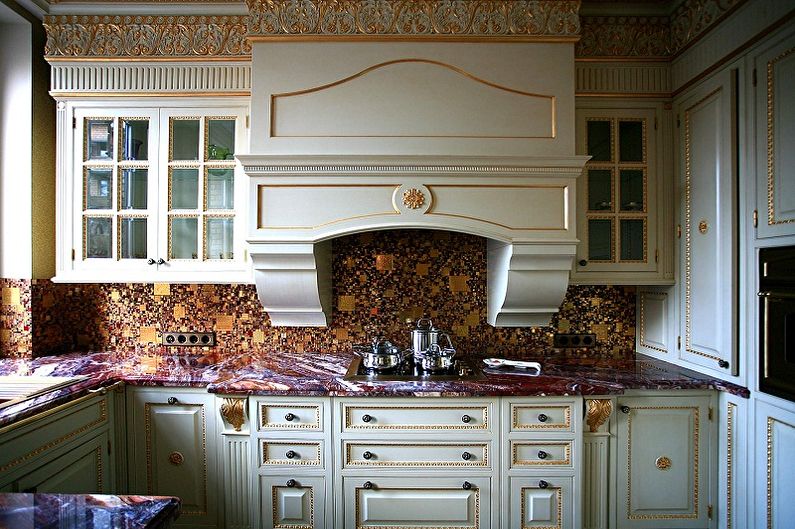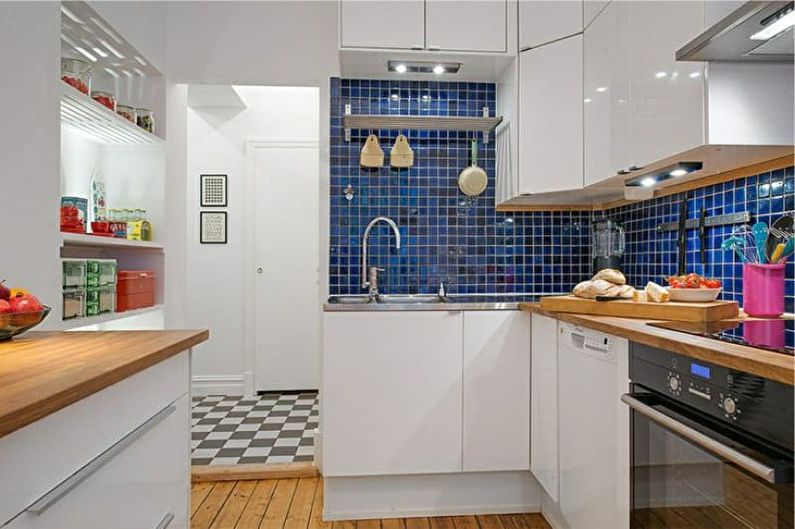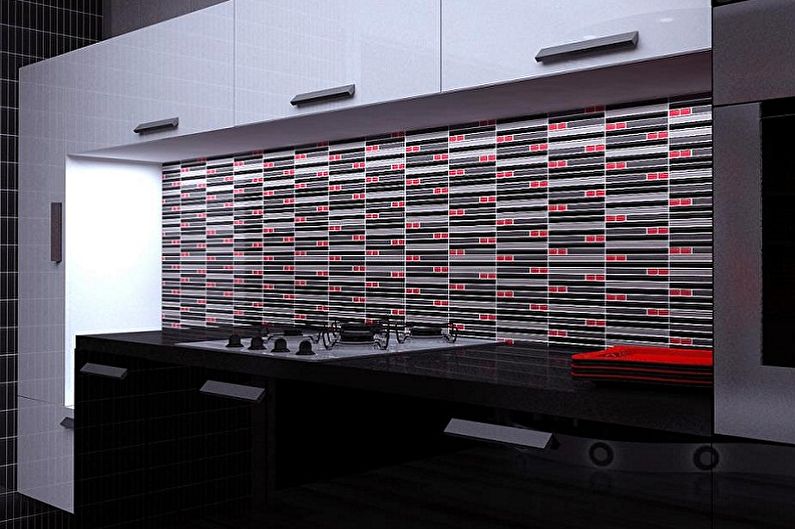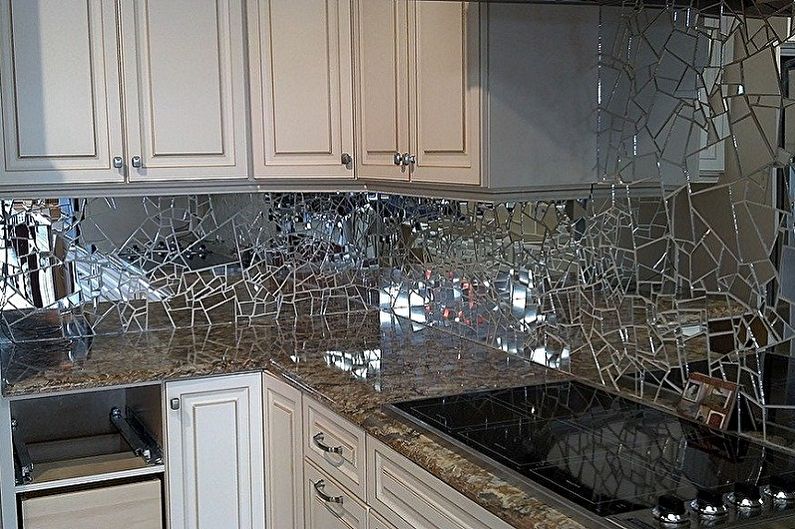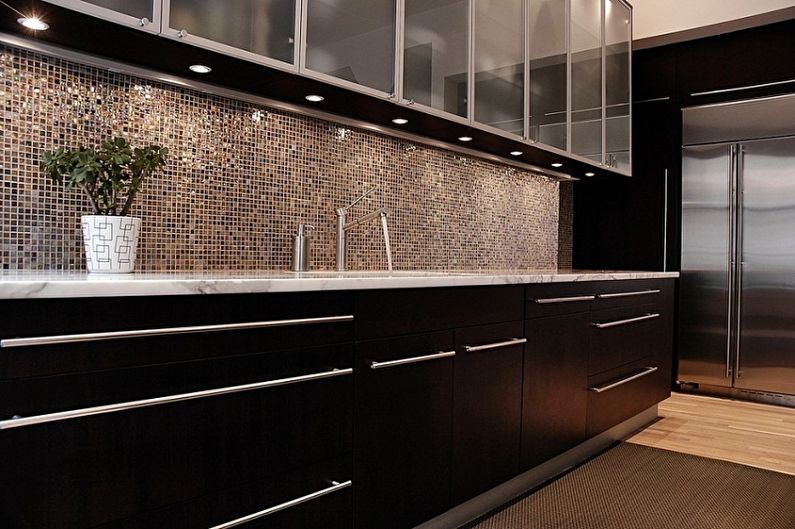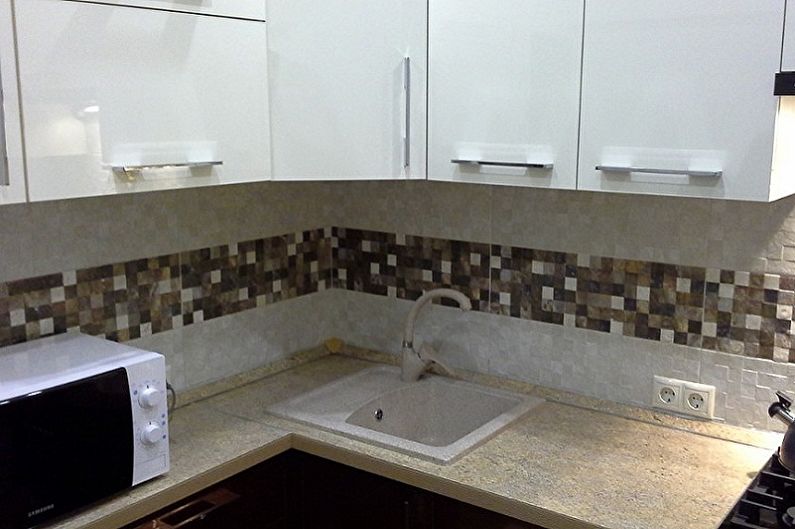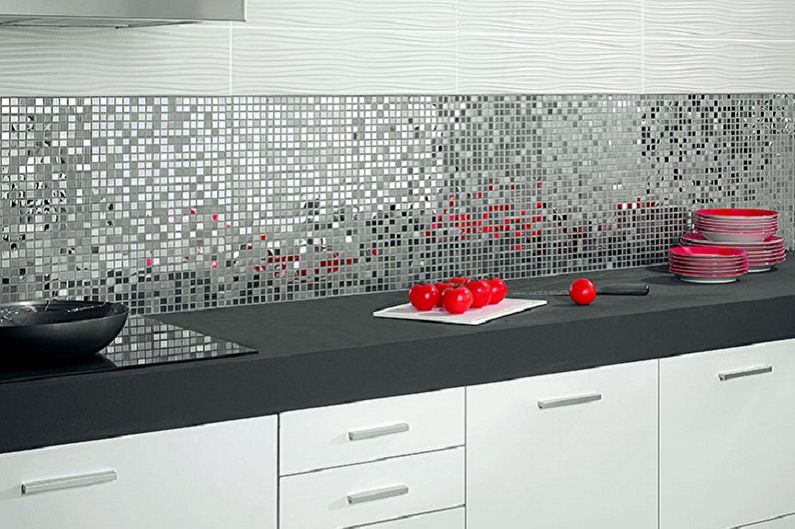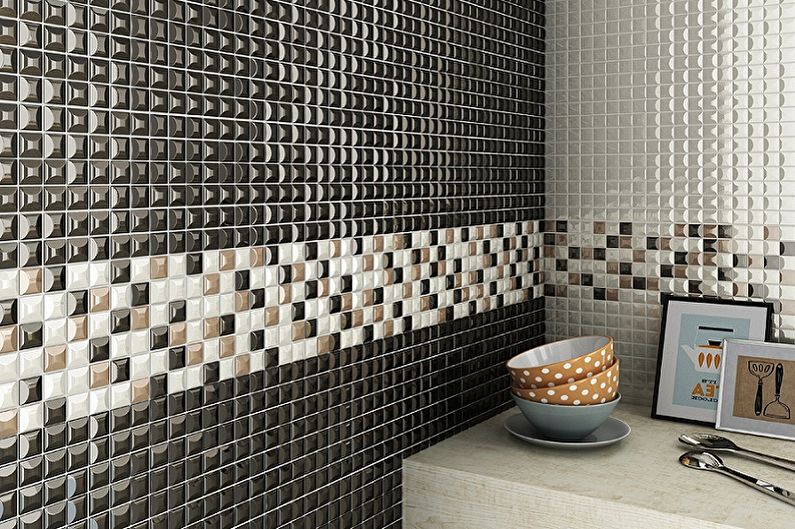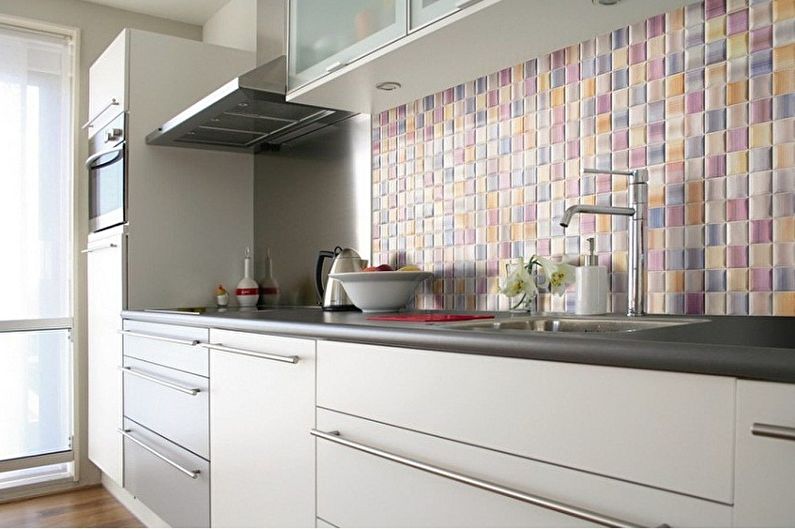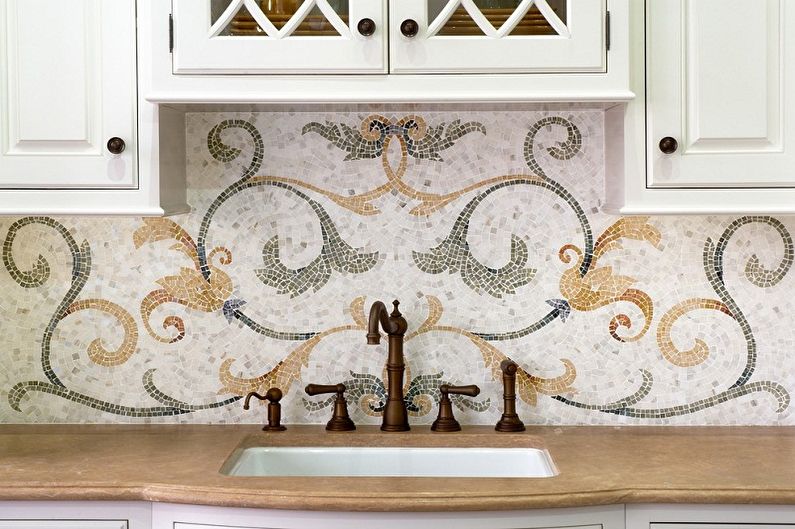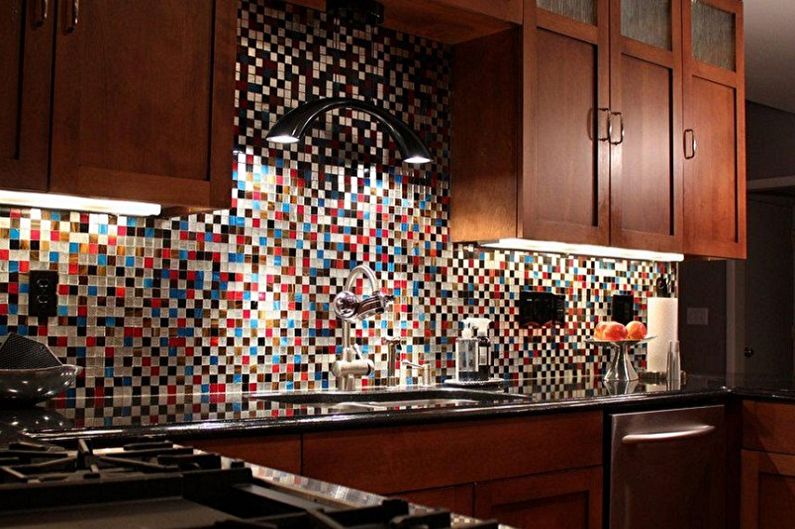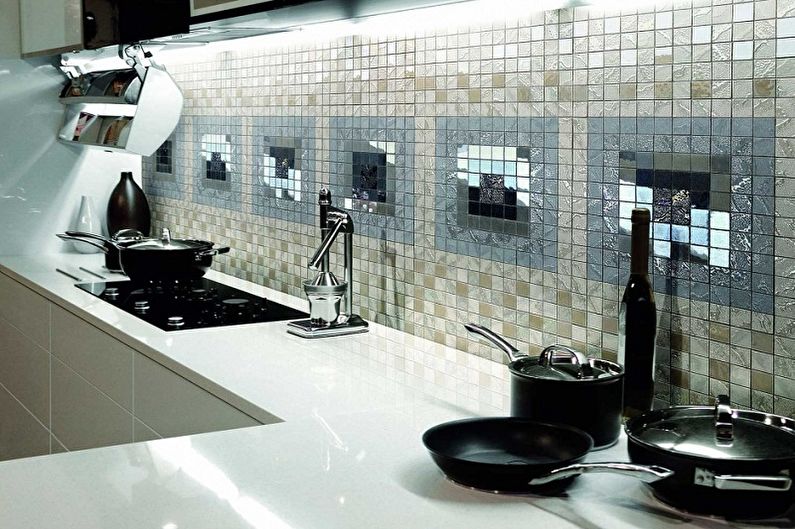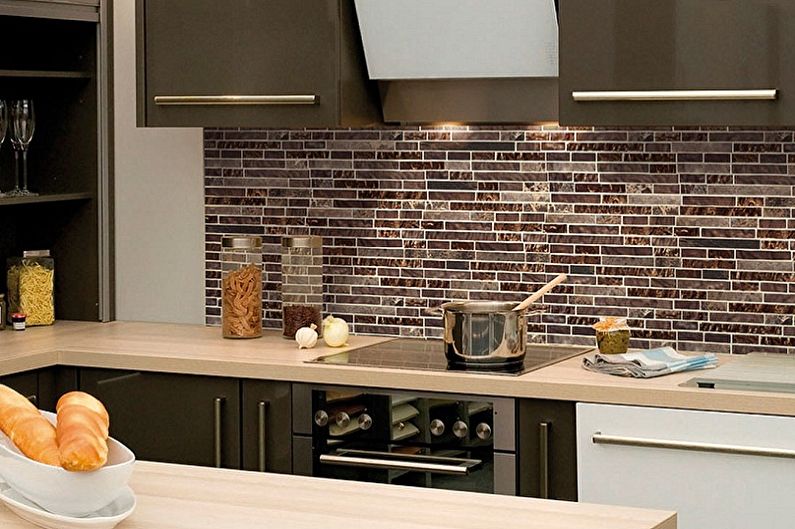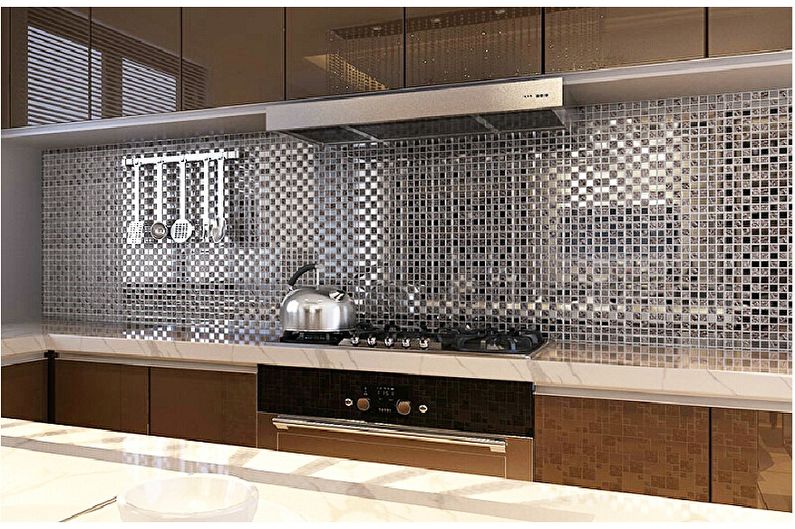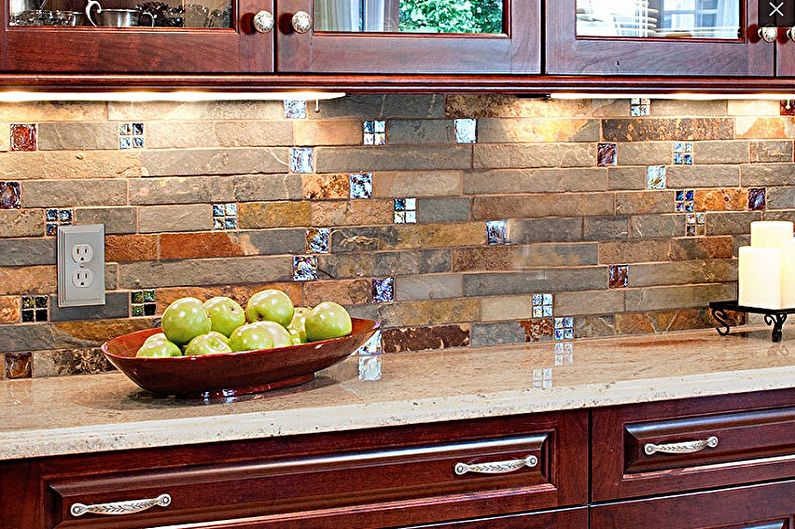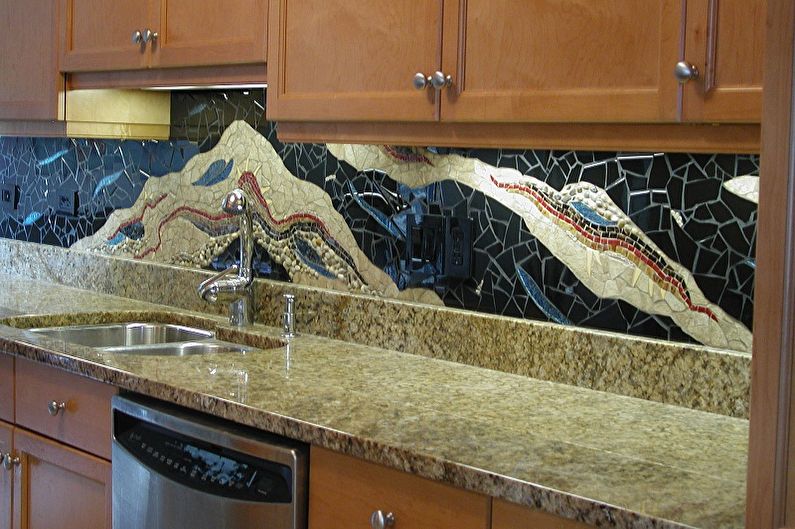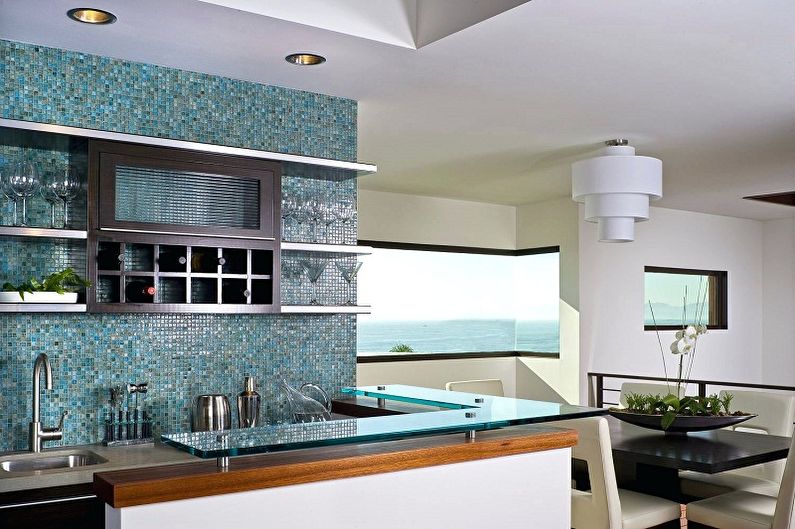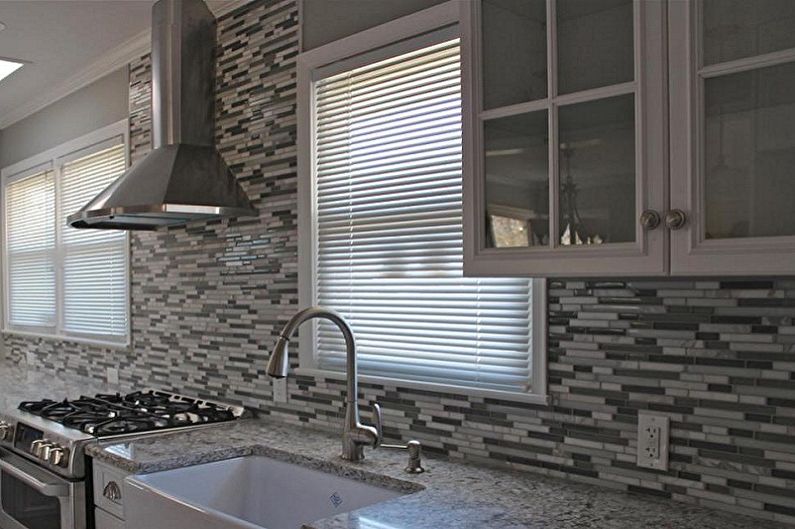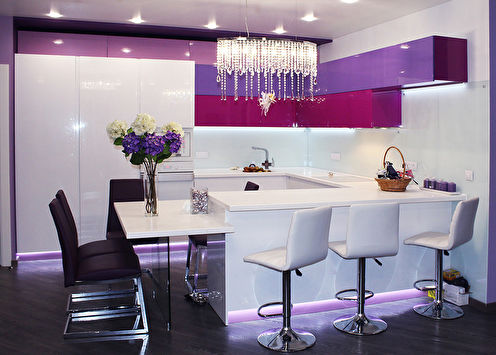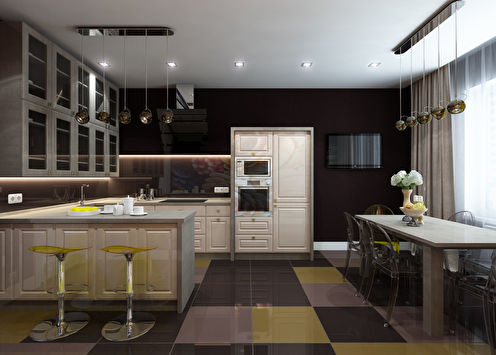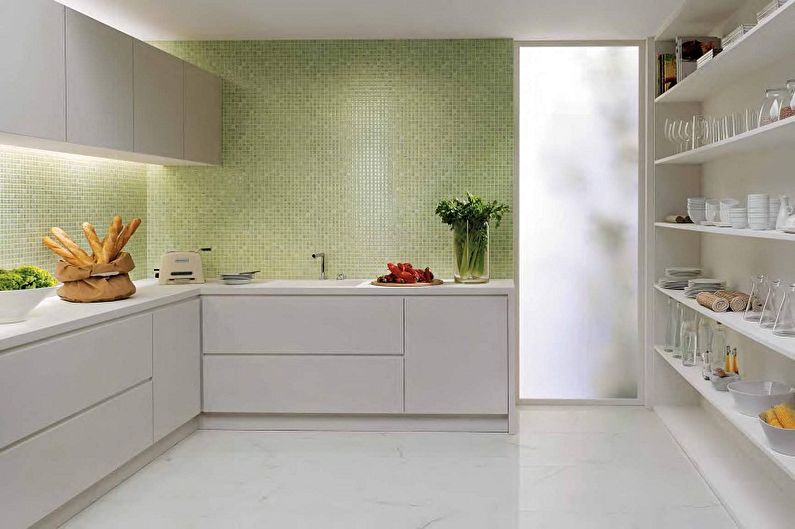
The working area deserves special attention in the design of the kitchen, as it is most susceptible to negative influences. Here the most complex kitchen processes reign, which are accompanied by the increased temperature emitted by the hob, humidity and contamination of not only the countertops, but also the adjacent walls. It is important to choose a decent practical material that will not only protect the walls, but also fulfill the role of a magnificent decor. Mosaic - one of the most popular types of finishing apron, which copes with its functions. In our article, we will consider various types of mosaics, as well as ideas for designing a work area in modern stylish interiors.
Mosaic Features: Pros and Cons
Mosaic canvas is made from particles of various materials, which are then applied to a special base. The most popular today are glass and ceramic mosaics, there are also options for using multi-colored stones, smalt, wood. Any of these materials allows you to create unique panels that have a lot of advantages, for example:
- A lot of color solutions, so you can choose a mosaic apron for any color of the kitchen, make the transition from the lower tier to the upper in a two-color headset or create a bright accent in the room;
- Resistance to any external influences - the mosaic has increased moisture and heat resistance, the ability to withstand any chemicals, acids, as a result of which cleaning is simplified;
- The possibility of easy recovery in case of damage to the picture;
- High artistic possibilities - the presence of small fragments in the composition allows you to create various decorative drawings from a simple pattern or ornament to a complex intricate composition;
- Long service life - the mosaic is considered one of the most durable materials, which does not lose its qualities for years, and sometimes decades;
- Suitability of the material for the design of any architectural features: small ledges, kinks, corners, minor details.
Despite the mass of its advantages, the mosaic still conceals some disadvantages. First of all, this applies to multiple seams that require careful grouting. The constant care of the seams can be quite a laborious task for someone. Making a mosaic apron will cost significantly more than tiling, and this is not about the price of the material, but the cost of the work of specialists, without which you can not do in this painstaking business. The work with mosaic matrices, which are panels 30x30 cm in size, on which a layer of material is applied, greatly simplifies the task.
It should be noted that the mosaic is laid out on perfectly smooth walls, which will also require additional effort and financial costs. If you are not afraid of these difficulties, we will consider what types of mosaics can be used to decorate an apron in the kitchen.
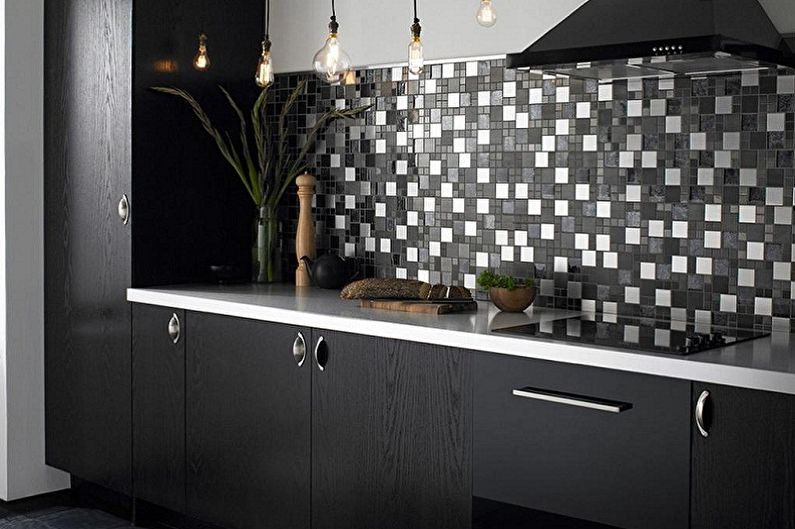
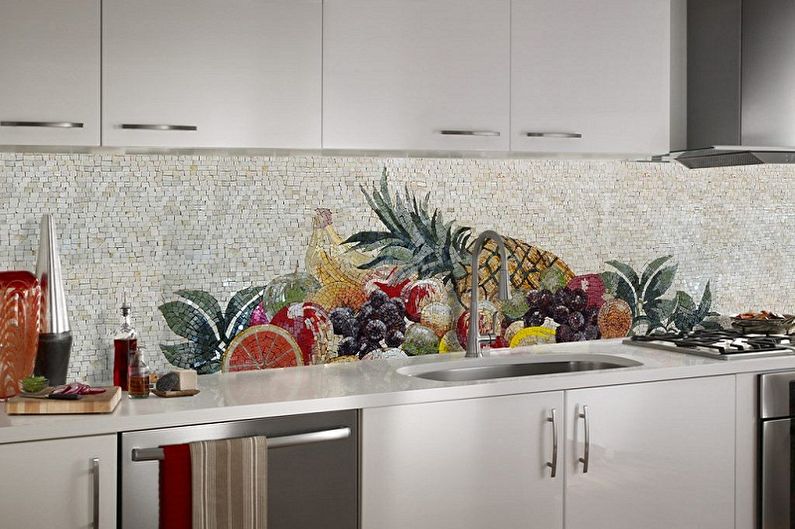
Mosaic design
One of the advantages of the material is its diversity. First of all, this applies to particle sizes - tessers making up the canvas. The smallest have dimensions of 1x1 cm, and the largest - 10x10 cm can be compared with ceramic tiles. In addition to square shapes, tesseras can be in the form of rhombuses, triangles, circles or broken elements. Using various combinations, you can create a wide variety of masterpieces in the work area.
Choose color
Like any modern finishing material, the mosaic has many colors.In some cases, it even surpasses other types of facing the working area with its colorful combinations and patterns. The most common types of color interpretations include:
1. Monocolor. In this case, the mosaic canvas is laid out from elements having the same size and color. This design is perfect for modern interiors in the spirit of minimalism, as well as oversaturated with bright colors.
2. The gradient. A distinctive feature is rectangular tessers, which seem to be stretched along the working surface. Overflowing shades creates original visual effects, expanding or raising the plane of the apron.
3. Mix. To design an apron, one leading color is selected, and several of its halftones, the presence of neutral white and black blotches is possible to create a pattern. A kitchen apron in this design will become a significant decoration of the room in any style, if you select the dominant key. He will introduce some dynamics and “stir up” the bored laconicism of the interior.
4. The panel. A great option for connoisseurs of paintings and patterns. Mosaic is a ready-made set of matrices that make up a particular image. This type of finish requires a leisurely installation, but this drawback is fully justified by the excellent appearance.
It should be noted that their cost often depends on the choice of the number and brightness of the colors of the mosaic matrices. The most economical option is monocolor, the production technology of which is not as complicated as in other versions, for example, in the case of panels.
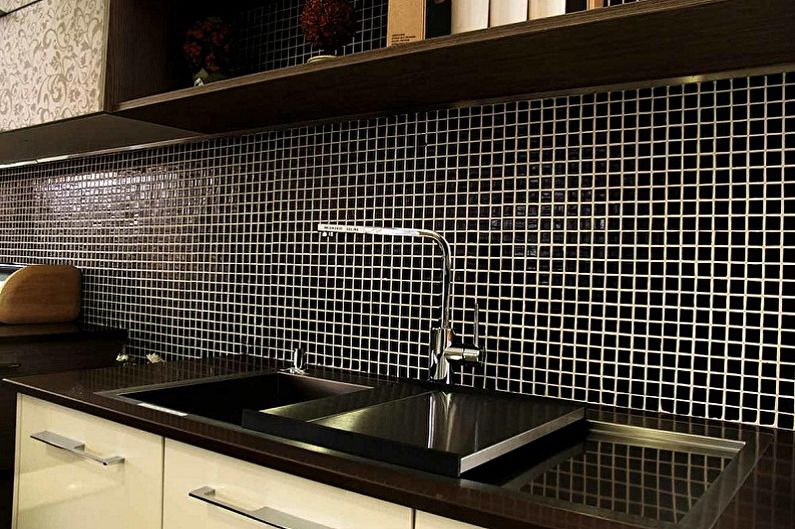
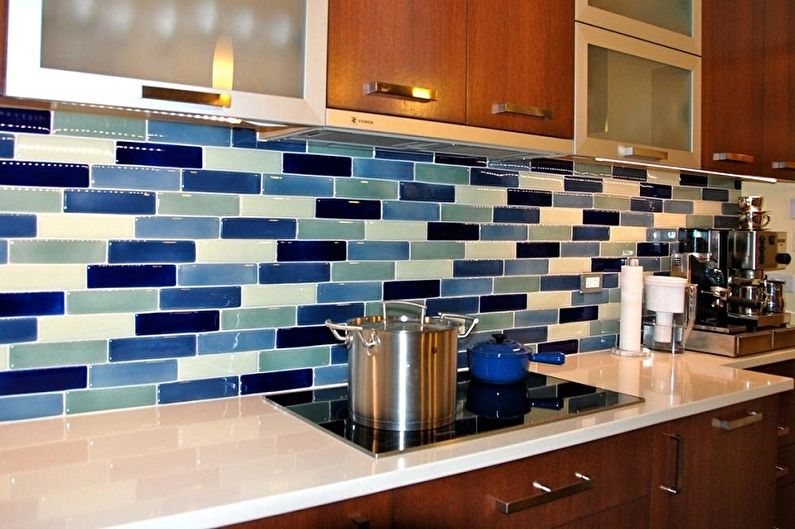
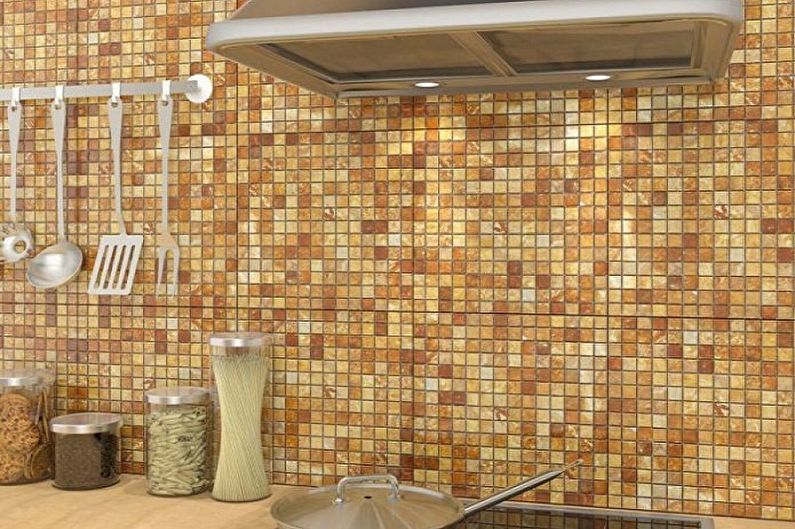
Types of mosaic matrices
If you want to simplify the process of mosaic design, without bothering with the painstaking installation of each individual element, you can choose the most suitable type of mosaic matrix. There are several types that differ in the principle of connecting the tessers and fastening to the surface. The most convenient way of laying have panels based on a polymer mesh. By the time spent on work and the consumption of adhesive - this is the most economical option. In addition, the grid is a kind of reinforcement that prevents the elements from decaying.
There are paper-based matrices on which the tessers are glued on the front side. After sticking the mosaic onto the apron, the paper is simply peeled off.
Self-adhesive panels are similar to double-sided tape; no additional adhesive composition is required for installation. Such canvases are perfectly fixed to the plastic and glass surfaces of the apron, but are completely unsuitable for plastered planes.
There are also matrices with polymer jumpers that are removed during installation. However, such compounds are recognized as unreliable, therefore, such matrices are not in great demand.

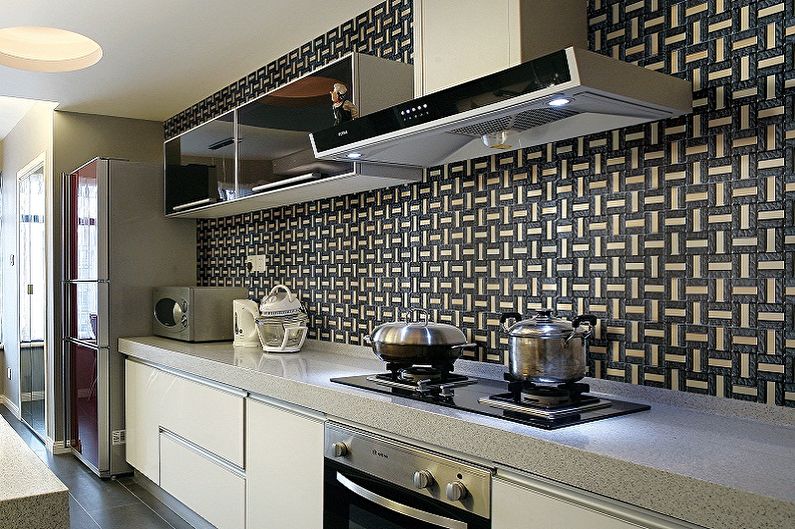
Mosaic kitchen apron design ideas
To date, the raw materials for the manufacture of mosaics are various materials, but you need to take into account the special conditions of the kitchen, where there is high humidity and temperature extremes. In addition, while in the working area, the finish will be constantly exposed to contamination, so you need to choose a coating that is well washed. In addition to practical characteristics, it is worth considering the style of the interior - because the apron lining is one of the components of the kitchen design, which should look harmonious.
Ceramic apron
This type is a miniature similarity to all of us familiar tiles, but the price is significantly different upwards. This is an indispensable type for oriental-style kitchens, although if you choose the right palette and type of coating, you can choose a ceramic mosaic for any other style. For the Scandinavian and rural areas, a working wall of matte mosaic patches imitating patchwork tiles is suitable, and a gradient mosaic of gray-beige shades will become a decoration of a minimalist interior.


Glass and mirror mosaic
Glass is the most demanded material in modern interiors. Despite the identity of the composition, the mosaic differs from glass tiles in higher strength indicators, due to the small size of the tessers. There are several main types, such as:
Mosaic of homogeneous (Venetian) glass, which consists of individual small blocks. Fragments can be monophonic or motley, have gloss, fragments of foil and other decorative inclusions in the composition;
Smalt - pressed glass, which in the course of processing takes the form of a homogeneous color mixture. The composition includes oxides of various metals (copper, iron, silver), so that the mosaic has an incomparably beautiful appearance, shimmering with shades with internal glow. This is a great option for luxurious classic interiors. The strength of the material is so great that it can be used to design the surface of the floor;
Mirror mosaic - looks very attractive and dynamic, ideal for the ultra-modern high-tech style. In addition to creating a special sparkling effect, it is often involved in adjusting the space, making it wider at the visual level. The combination of mirror and pearl mosaic looks gorgeous.
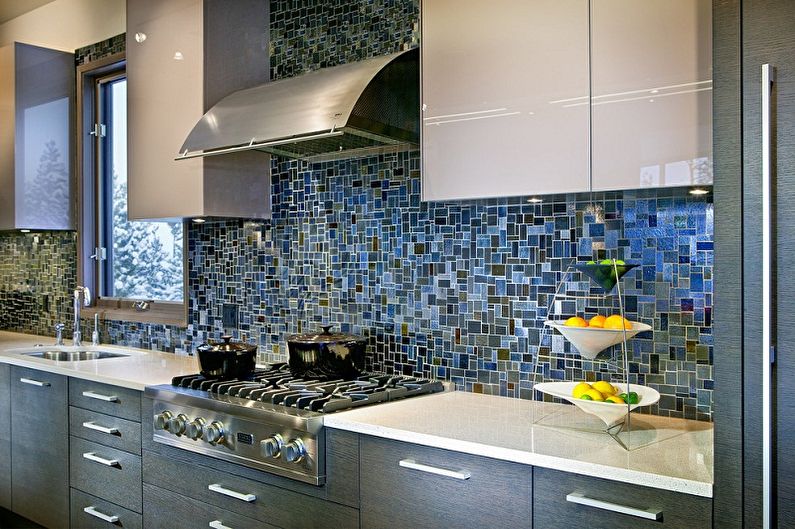
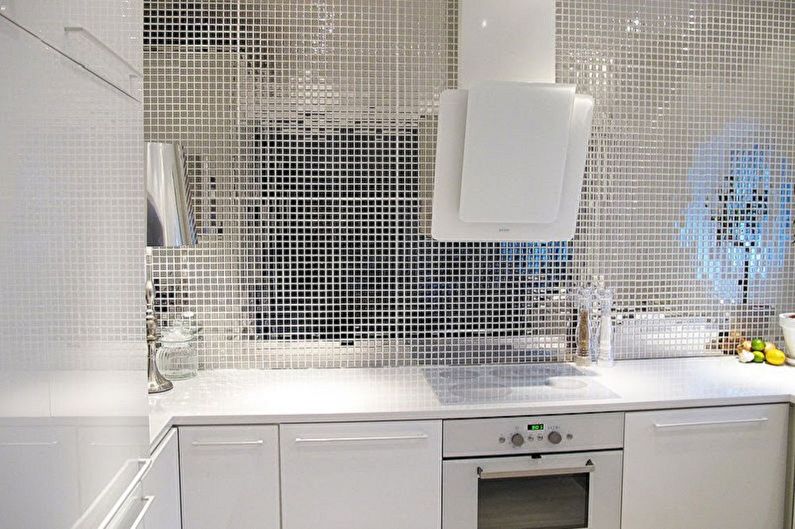
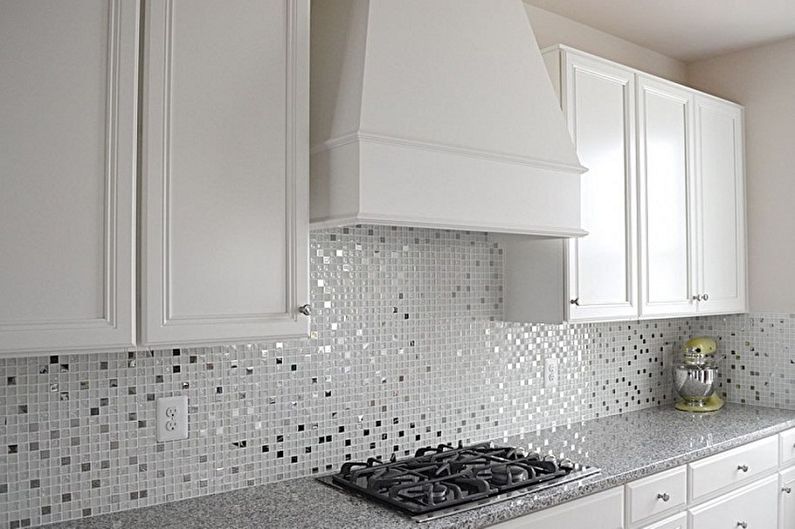
Making apron with stone mosaic
Natural stone has a unique and unique look and the highest performance characteristics. A variety of colors, shapes and textures of stone mosaics allows you to choose it for any interior style. In the manufacturing process, mineral and stone chips, including marble, onyx fragments, are introduced into the structure, so this finish claims to be elite and has a considerable cost.
The coating can be absolutely smooth or have “intentional” signs of aging, obtained in the process of sandblasting. Tiny shabby bricks on an apron emphasize the naturalness of the loft kitchen, and a mosaic of polished marble will adequately decorate any respectable interior.
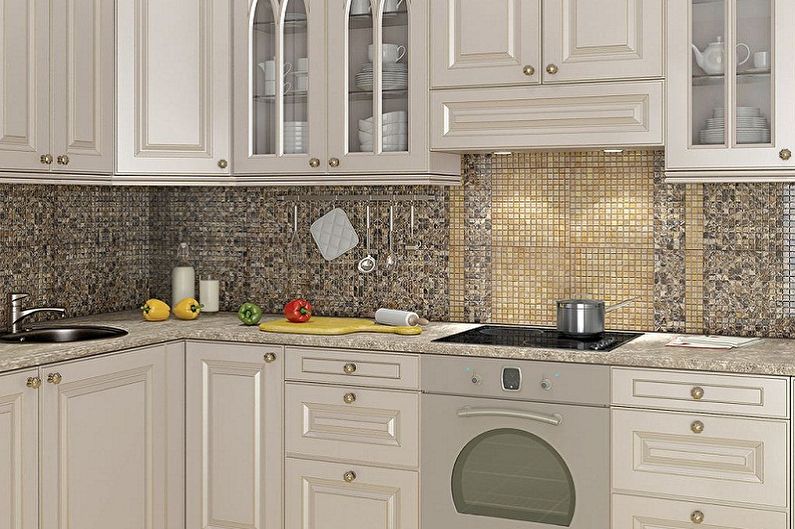
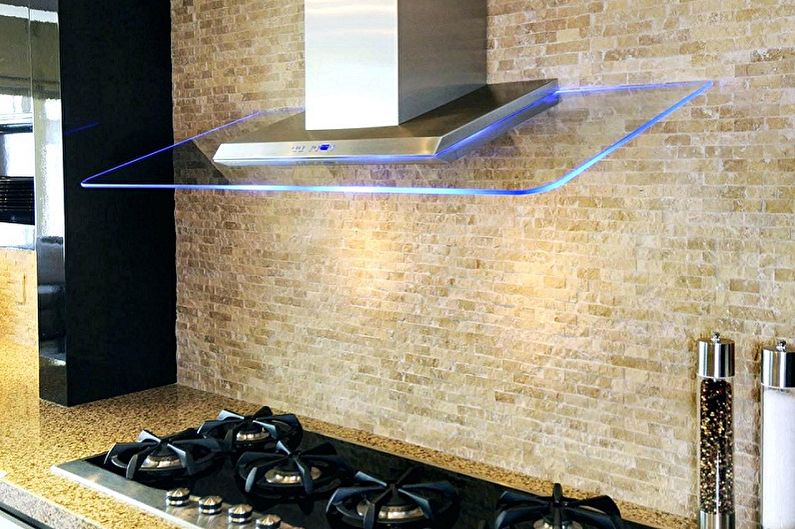
Mosaic kitchen apron - photo
Summing up, we suggest our reader to visit the photo gallery, where many examples of beautiful aprons for the kitchen from mosaics are collected. Here you can see how attractive and relaxed the elegant design looks with small tiles of the working area and draw a lot of interesting ideas. Enjoy watching!
